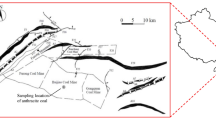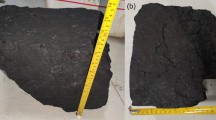Abstract
Intermediate geotechnical materials such as Victorian Brown Coal (VBC) often exhibit complex fracture characteristics due to the interplay of ductile and brittle behaviour. A diverse set of in situ joint orientations and fracture characteristics are found in the open-cut mines of the Latrobe Valley, Victoria, Australia. As such, the propagation of pre-existing discontinuities plays a significant role in the potential failure mechanisms of open-cut mines in the region. Although field assessment has yielded a range of Victorian Brown Coal in situ joint characteristics, insufficient data exists to determine the relationship between the fracture orientation of VBC and joint compressive strength. To supplement available site investigation data, experimental results of uniaxial compressive tests on pre-fractured Victorian Brown Coal specimens performed under laboratory conditions are presented for various crack angles to determine the relationship between fracture angle and joint compressive strength. Fractured VBC is found to exhibit a reduced uniaxial compressive strength, with appreciably varied fracture propagation characteristics depending on the fracture initiation angle. Laboratory tests were conducted on soaked VBC specimens containing predefined cracks (for angles of 0°, 15°, 30°, 45° and 60° to the axis of symmetry) as well as intact coal specimens, with fracture propagation paths photographed along the specimen surface. Intact coal specimens under compression experienced brittle failure with crack propagation parallel to the direction of loading. For specimens with pre-existing fractures, the crack angle was observed to significantly affect the failure mode and the direction of crack propagation. Obtained results suggest pre-existing crack angles alter the shape of the stress–strain curve, with a range of unconfined compressive strengths and crack initiation strengths presented. It was noted that pre-existing crack angles of 45° yielded the minimum observed failure stress. Given the presence of desiccation cracks, micro-cracks and large-scale jointing within Victorian Brown Coal, compressive strength parameters for a range of joint characteristics are vital to ensuring the ongoing stability of the large open-cut mine slopes within the region.













Similar content being viewed by others
Abbreviations
- IGM:
-
Intermediate Geotechnical Material
- \(J_{n}\) :
-
Number of joints per metre
- Jf :
-
Joint factor
- JRC:
-
Joint Roughness Coefficient
- JCS:
-
Joint Compressive Strength
- R:
-
Rebound number
- UCS:
-
Unconfined Compressive Strength
- UET:
-
Unconfined Expansion Test
- VBC:
-
Victorian Brown Coal
- \(\gamma_{d}\) :
-
Dry density
- \(\sigma_{n}\) :
-
Normal stress
- \(\sigma_{c}\) :
-
Unconfined Compressive Strength
- \(\phi_{b}\) :
-
Friction angle
- \(\tau\) :
-
Shear strength
- c:
-
Cohesion
References
Asadizadeh M, Moosavi M, Hossaini MF, Masoumi H (2018) Shear strength and cracking process of non-persistent jointed rocks: an extensive experimental investigation. Rock Mech Rock Eng 51(2):415–428
Ashby MF, Hallam S (1986) The failure of brittle solids containing small cracks under compressive stress states. Acta Metall 34(3):497–510
ASTM (2012) STANDARD D388-12. Standard classification of coals by rank. American Society for Testing and Materials
ASTM (2014) ASTM D5873-14, standard test method for determination of rock hardness by rebound hammer method. ASTM International
Atkinson B, Avdis V (1980) Fracture mechanics parameters of some rock-forming minerals determined using an indentation technique. Int J Rock Mech Min Sci Geomech Abstr 17:383–386
Barton N (1973) Review of a new shear-strength criterion for rock joints. Eng Geol 7(4):287–332
Barton N, Choubey V (1977) The shear strength of rock joints in theory and practice. Rock Mech 10(1–2):1–54
Barton N, Bandis S, Bakhtar K (1985) Strength, deformation and conductivity coupling of rock joints. Int J Rock Mech Min Sci Geomech Abstr 121–140
Barton CM, Gloe CS, Holdgate GR (1993) Latrobe Valley, Victoria, Australia: a world class brown coal deposit. Int J Coal Geol 23(1):193–213
Behnia M, Goshtasbi K, Marji MF, Golshani A (2015) Numerical simulation of interaction between hydraulic and natural fractures in discontinuous media. Acta Geotech 10(4):533–546
Bobet A, Einstein H (1998) Fracture coalescence in rock-type materials under uniaxial and biaxial compression. Int J Rock Mech Min Sci 35(7):863–888
Brace W, Byerlee JD (1966) Recent experimental studies of brittle fracture of rocks. In: The 8th US symposium on rock mechanics (USRMS). American Rock Mechanics Association
Brady BH, Brown ET (2013) Rock mechanics: for underground mining. Springer, New York
Broberg KB (1999) Cracks and fracture. Academic Press, Boca Raton
Cao P, Liu T, Pu C, Lin H (2015) Crack propagation and coalescence of brittle rock-like specimens with pre-existing cracks in compression. Eng Geol 187:113–121
Chen X, Liao Z-H, Peng X (2013) Cracking process of rock mass models under uniaxial compression. J Cent South Univ 20(6):1661–1678
Dyson AP, Tolooiyan A (2019a) Prediction and classification for finite element slope stability analysis by random field comparison. Comput Geotech 109:117–129
Dyson AP, Tolooiyan A (2019b) Probabilistic investigation of RFEM topologies for slope stability analysis. Comput Geotech 114:103129
Dyson AP, Tolooiyan A (2019) Comparative approaches to probabilistic finite element methods for slope stability analysis. Simul Model Pract Theory 102061
Dyson AP, Tang Z, Tolooiyan A (2018) Use of stochastic XFEM in the investigation of heterogeneity effects on the tensile strength of intermediate geotechnical materials. Finite Elem Anal Des 145:1–9
Gehle C, Kutter H (2003) Breakage and shear behaviour of intermittent rock joints. Int J Rock Mech Min Sci 40(5):687–700
Ghamgosar M, Erarslan N, Williams D (2017) Experimental Investigation of fracture process zone in rocks damaged under cyclic loadings. Exp Mech 57(1):97–113
Goldstein M, Goosev B, Pvrogovsky N, Tulinov R, Turovskaya A (1966) Investigation of mechanical properties of cracked rock. In: 1st ISRM congress: international society for rock mechanics and rock engineering
Haeri H, Shahriar K, Marji MF, Moarefvand P (2014) Experimental and numerical study of crack propagation and coalescence in pre-cracked rock-like disks. Int J Rock Mech Min Sci 67:20–28
Halakatevakis N, Sofianos A (2010) Strength of a blocky rock mass based on an extended plane of weakness theory. Int J Rock Mech Min Sci 47(4):568–582
Hoek E, Bieniawski Z (1965) Brittle fracture propagation in rock under compression. Int J Fract Mech 1(3):137–155
Hoek E, Martin C (2014) Fracture initiation and propagation in intact rock—a review. J Rock Mech Geotech Eng 6(4):287–300
Horii H, Nemat-Nasser S (1985) Compression-induced microcrack growth in brittle solids: Axial splitting and shear failure. J Geophys Res Solid Earth 90(B4):3105–3125
Ichikawa Y, Kawamura K, Uesugi K, Seo Y-S, Fujii N (2001) Micro-and macrobehavior of granitic rock: observations and viscoelastic homogenization analysis. Comput Methods Appl Mech Eng 191(1–2):47–72
Industries DoEaP (2012) About Victoria’s brown coal. Department of Environment and Primary Industries
Lajtai E (1969) Strength of discontinuous rocks in direct shear. Geotechnique 19(2):218–233
Lajtai E, Carter B, Duncan E (1994) En echelon crack-arrays in potash salt rock. Rock Mech Rock Eng 27(2):89–111
Lin CC, Jeng SM, Li LJ (2002) Method to improve the crack resistance of CVD low-k dielectric constant material. Google Patents
Liu K, Mackay R, Xue J, Tolooiyan A (2014) Experimental study of brown coal hydraulic behavior at low confining stress
Maji V, Sitharam T (2012) Testing and evaluation of strength and deformation behaviour of jointed rocks. Geomech Geoeng 7(2):149–158
Miller RP (1965) Engineering classification and index properties for intact rock. Ph.D. thesis, University of Illinois
Moein F, Xue J, Dent B, Mackay R (2016) Review of the historical data characterizing Latrobe Valley brown coal consolidation behaviour. In: Eggers MJ, Griffiths JS, Parry S, Culshaw MG (eds) Developments in engineering geology. Geological Society of London, London
Perera M, Ranjith P, Peter M (2011) Effects of saturation medium and pressure on strength parameters of Latrobe Valley brown coal: carbon dioxide, water and nitrogen saturations. Energy 36(12):6941–6947
Prudencio M, Jan MVS (2007) Strength and failure modes of rock mass models with non-persistent joints. Int J Rock Mech Min Sci 44(6):890–902
Resource AM (2011) The Australian atlas of mineral resources, mines, and processing centres. Commonwealth of Australia
Roxborough FF (1987) The role of some basic rock properties in assessing cuttability. Seminar on tunnels: wholly engineered structures. The Institute of Engineers Australia and AFCC
Sammis C, Ashby M (1986) The failure of brittle porous solids under compressive stress states. Acta Metall 34(3):511–526
Shaghaghi T, Ghadrdan M, Tolooiyan A (2020) Design and optimisation of drainage systems for fractured slopes using the XFEM and FEM. Simul Model Pract Theory 102110
Spurrier PL (1986) Brown coal: Victoria’s vital resource. Energy. 11(11–12):1251–1257
Tang C, Lin P, Wong R, Chau K (2001) Analysis of crack coalescence in rock-like materials containing three flaws—part II: numerical approach. Int J Rock Mech Min Sci 38(7):925–939
Tang Z, Tolooiyan A, Mackay R (2017) Unconfined Expansion Test (UET) for measuring the tensile strength of organic soft rock. Comput Geotech 82:54–66
Tolooiyan A, Mackay R, Xue J (2014) Measurement of the tensile strength of organic soft rock BT—measurement of the tensile strength of organic soft rock. ASTM Geotech Test J 37(6)
Tolooiyan A, Dyson A, Karami M, Shaghaghi T, Ghadrdan M (2019) Application of ground penetrating radar (GPR) to detect joints in organic soft rock. Geotech Test J
Vásárhelyi B, Ván P (2006) Influence of water content on the strength of rock. Eng Geol 84(1–2):70–74
Viete D, Ranjith P (2006) The effect of CO2 on the geomechanical and permeability behaviour of brown coal: implications for coal seam CO2 sequestration. Int J Coal Geol 66(3):204–216
Vutukuri V, Lama R, Saluja S (1974) Handbook on mechanical properties of rocks. Testing techniques and results. Volume 1. Int J Rock Mech Min Sci Geomech Abstr A218
Xue J, Tolooiyan A (2012) Reliability analysis of block sliding in large brown coal open cuts. In: The 2012 world congress on advances in civil, environmental, and materials research (ACEM’12), pp 1578–1587
Yang S-Q (2011) Crack coalescence behavior of brittle sandstone samples containing two coplanar fissures in the process of deformation failure. Eng Fract Mech 78(17):3059–3081
Zhang B, Li S, Zhang D, Li M-T, Shao D-L (2012) Uniaxial compression mechanical property test, fracture and damage analysis of similar material of jointed rock mass with filled cracks. Rock Soil Mech 33(6):1647–1652
Zhou Z, Cai X, Cao W, Li X, Xiong C (2016) Influence of water content on mechanical properties of rock in both saturation and drying processes. Rock Mech Rock Eng 49(8):3009–3025
Acknowledgements
Financial support for this research has been provided by China Scholarship Council (CSC) and Earth Resources Regulation of the Victorian State Government Department of State Development, Business and Innovation (Grant No. GHERG Continuation Fund). The authors would like to thank Mr. Wayne Powrie, who prepared the equipment and specimens for this research. The assistance of the Yallourn mine of Victoria, Australia is also acknowledged for their support and help with specimen collection and access to defect mapping data.
Author information
Authors and Affiliations
Corresponding author
Additional information
Publisher's Note
Springer Nature remains neutral with regard to jurisdictional claims in published maps and institutional affiliations.
Rights and permissions
About this article
Cite this article
Wen, J., Tang, Z., Dyson, A.P. et al. The mechanical behaviour of pre-existing transverse cracks in lignite under uniaxial compression. Geomech. Geophys. Geo-energ. Geo-resour. 7, 6 (2021). https://doi.org/10.1007/s40948-020-00201-w
Received:
Accepted:
Published:
DOI: https://doi.org/10.1007/s40948-020-00201-w




